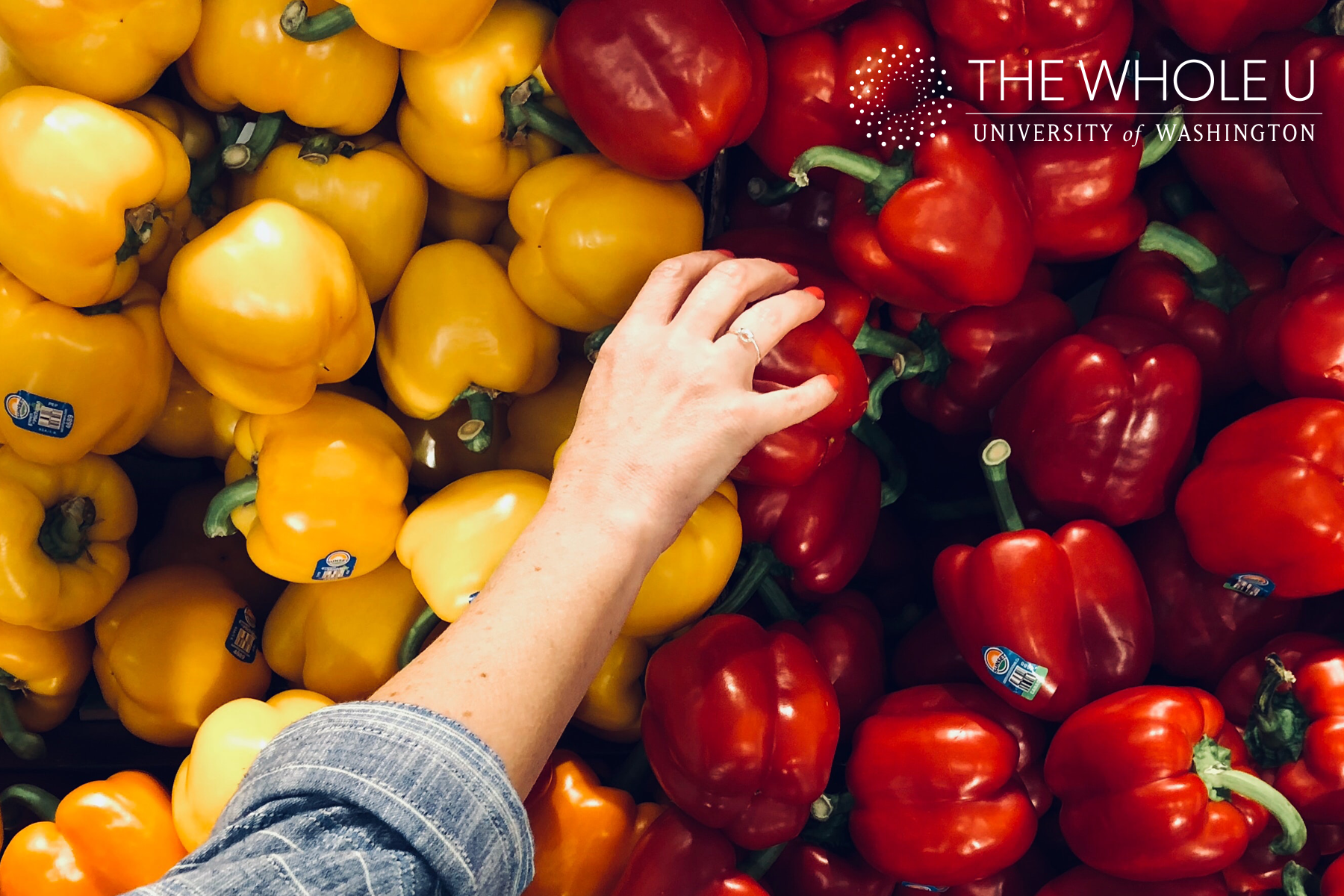
How to safely shop for food during COVID-19
The emergence of COVID-19 has had an unprecedented impact on people around the world. Daily uncertainties often lead to more questions than answers on how to protect ourselves and our communities from a disease with a nebulous mode of transmission.
Given we internalize the external environment when we eat, it is no surprise that questions abound on the safety of our food and food supply in light of COVID-19. To address some of these questions, we connected with Iwona Steplewska, MS, RD and Megan Nordlund, MS, RD, Clinical Nutrition Manager at Harborview Medical Center, who provided answers.
How does COVID-19 impact food safety?
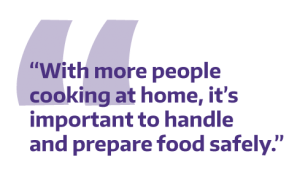 IS: According to the CDC, currently there is no evidence to support the transmission of COVID-19 from touching either food or food packaging. However, the virus can survive on surfaces and objects for a limited amount of time. The available evidence suggests the virus can survive for about 3 days on hard surfaces, like metal or plastic, and about 1 day on soft surfaces, like cardboard. Proper hand hygiene is critical.
IS: According to the CDC, currently there is no evidence to support the transmission of COVID-19 from touching either food or food packaging. However, the virus can survive on surfaces and objects for a limited amount of time. The available evidence suggests the virus can survive for about 3 days on hard surfaces, like metal or plastic, and about 1 day on soft surfaces, like cardboard. Proper hand hygiene is critical.
Per CDC’s guidelines: “In general, because of poor survivability of these coronaviruses on surfaces, there is likely very low risk of spread from food products or packaging that are shipped over a period of days or weeks at ambient, refrigerated, or frozen temperatures.” More info here.
Changes due to social distancing and stay-at-home orders also heighten the importance of other food safety concerns.
With folks perhaps purchasing food products in larger quantities, it is important to check expiration dates and to ensure canned goods are not dented. Also, with more people cooking at home, it’s important to handle and prepare food safely. This includes keeping raw meat separate from other foods, refrigerating perishable foods, and cooking meat to the right temperature to kill harmful germs. Information on food safety from the CDC can be found here.
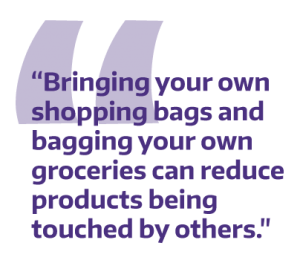 How often should I go to the grocery store to shop?
How often should I go to the grocery store to shop?
IS: In order to limit exposure and comply with social distancing regulations, it’s been advised to minimize the number of trips to the grocery store. Once per week should be sufficient in most cases.
Making a meal plan along with a grocery shopping list can be tremendously helpful to speed up the shopping process. If you know the store layout, making a grocery list while keeping the store layout in mind can further improve the shopping experience and speed.
Bringing your own shopping bags, and bagging your own groceries can also reduce products being touched by others. Harvard School of Public Health has fantastic resources on this topic here.
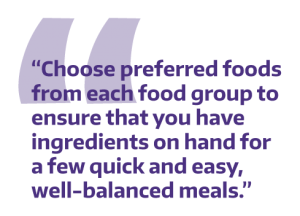 What food items should I have in my pantry?
What food items should I have in my pantry?
IS: A well-stocked pantry can be very helpful with cooking meals at home. There are numerous food staples or pantry lists online, which typically include oil, sugar, flour, salt, spices, and vinegars as the foundation. My recommendation would be to choose preferred foods from each food group (i.e. grains, fruits, vegetables, protein and dairy) to ensure that you have ingredients on hand for a few quick and easy, well-balanced meals.
The USDA’s Choose My Plate guide can be helpful in this regard. They provide details regarding daily food groups and serving sizes: https://www.choosemyplate.gov/ as well as links to great information on the best food buys in each aisle for budget-friendly and healthy food options. They also have additional, COVID-19-specific resources here.
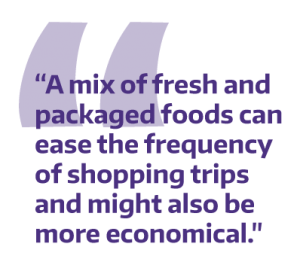 Should I only buy packaged food items?
Should I only buy packaged food items?
IS: There is no need to only purchase packaged goods. We know packaged products typically contain more sodium and preservatives. Choosing a healthy variety of foods is recommended.
A mix of fresh and packaged foods can ease the frequency of shopping trips and might also be more economical. Packaged foods offer additional benefits, such as longer shelf lives.
Should I buy canned/non-perishable food items so I don’t have to go to the grocery store often? Are these foods enough for a healthy/balance diet?
IS: Choosing canned/non-perishable food items can be a great way to stretch our “pantries” and sometimes, our budget. For short-term duration, these foods should be fine to tie us over. However, relying solely on these foods, can decrease variety – and meal enjoyment. Often, they lack fiber and are higher in sodium content. Since COVID is not thought to be transmitted via food, there is no need to limit food options to canned/non-perishable goods.
What foods should I be wiping down?
IS: From what I’ve read, folks should throw away food packaging and wipe down cans and bottles when one gets home.
However, do not put disinfectants, such as bleach or cleaning products, on produce or directly on food as this can be harmful to health. Although no recommendations regarding wiping down food products were noted on CDC’s website, the Harvard School of Public Health has published recommendations.
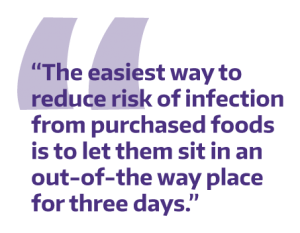 The Harvard School of Public Health suggests the easiest way to reduce the risk of infection from purchased foods is to let them sit in an out-of-the way place for three days. Of course, this does not include foods that need immediate refrigeration or freezing.
The Harvard School of Public Health suggests the easiest way to reduce the risk of infection from purchased foods is to let them sit in an out-of-the way place for three days. Of course, this does not include foods that need immediate refrigeration or freezing.
- For fresh produce, wash under running water and scrub the surface with a small amount of soap and water. The scrub brush should then be washed with additional soap and water after each use.
- For other perishables requiring refrigeration or freezing, it may be helpful to wash the container surface with a small amount of soap and water. Wash your hands again after doing so.
No recommendations regarding wiping down food products were noted on CDC’s website.
Is washing produce items with water enough to clean off any disease-causing bacteria/viruses?
IS: Yes, it appears to be. Rinsing produce for 20 seconds under running water and scrubbing vigorously should be fine, based on the data we have at this point in time. Some news outlets have recommended rinsing products with disinfecting solutions (including bleach), as well as vinegar and some other branded disinfectants — this is not the recommended practice. It can cause more harm than good, leading to possible contamination of perishable goods and/or toxic exposure.
Are there any food items I should avoid when at the grocery store?
IS: I would recommend avoiding bulk items, or baked goods sitting out without proper packaging. Ensure deli clerks are wearing gloves (changing frequently) and doing proper hand washing.
Many stores have implemented face masks for employees. Many stores have already implemented changes to aid reduce possible transmission and/or contamination, such as discontinuing bulk items as well as packaging fresh baked goods in plastic bags (vs just paper) to reduce exposure to droplets/hand touching.
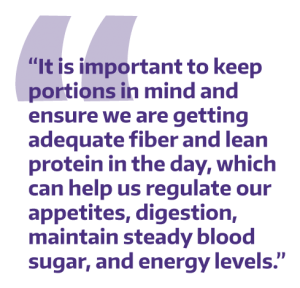 Are there any food items that I should avoid to stay healthy? E.g. processed or sugary foods?
Are there any food items that I should avoid to stay healthy? E.g. processed or sugary foods?
IS: I would recommend trying to purchase nutrient rich foods that make up the foundation of our dietary guidelines — such as whole grains, lean proteins, dairy, fruits and vegetables — to ensure we are getting sufficient vitamins/minerals.
However, many people are now facing increased responsibilities. Many are facing food insecurity. During these stressful times, a more permissive eating plan might be more realistic. Trying to keep in mind food balance and moderation, and not succumbing to “all or nothing” thinking, can go a long way to helping our physical and mental health. Having a pizza Friday, or tater tots with lunch can ease the burden of extra responsibilities without adding more stress to our daily food decisions.
Regarding sugary foods, my colleagues would probably agree that everything in moderation is perfectly fine and even recommended. Treats can be a very important part of a healthy diet.
It comes down to balance and moderation. It is important to keep portions in mind and ensure we are getting adequate fiber and lean protein in the day, which can help us regulate our appetites, digestion, maintain steady blood sugar, and energy levels. With less activity, constipation, poor digestion and depressed mood can become problems that can be exacerbated by sugary and nutrient poor foods.
Making sure we are also consuming vegetables and fruits, whole grains, lean proteins and legumes can benefit our physical and mental well-being. Those treats will taste that much better!
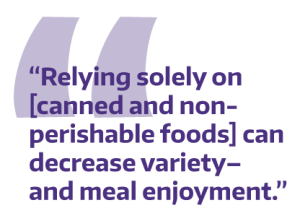 Should I buy canned/non-perishable food items so I don’t have to go to the grocery store often? Are these foods enough for a healthy/balanced diet?
Should I buy canned/non-perishable food items so I don’t have to go to the grocery store often? Are these foods enough for a healthy/balanced diet?
IS: Choosing canned/non-perishable food items can be a great way to stretch our “pantries” and sometimes our budget. For short term duration, these foods should be fine to tie us over. However, relying solely on these foods, can decrease variety –and meal enjoyment. Often, they lack fiber and are higher in sodium content.
Since COVID is not thought to be transmitted via food, there is no need to limit food options to canned/non-perishable goods.
Are frozen food items considered to be safer to consume?
IS: No.
Does the cold temperature in the fridge/freezer kill the virus?
IS: No data at this time indicates this.
Some news outlets have reported that frozen foods may actually harbor the virus. However, neither the CDC, nor other reputable sources have made any official statements regarding frozen foods and the viral load or lifespan of COVID-19.
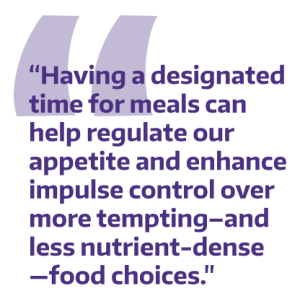
How can I stop snacking throughout the day?
IS: What might help during this time of uncertainty is trying to keep our eating on a schedule. Having a designated time for meals can help regulate our appetite and enhance impulse control over more tempting – and less nutrient-dense — food choices.
Staying well hydrated can also aid with appetite regulation. Plus, we know the benefits of staying well hydrated can helps us stay alert, focused and energized, which can possibly reduce our cravings for foods.
Ideally, 50% of our fluids each day should come from water. As a general rule of thumb, most of us need to drink between 8-10 cups of water per day.
To estimate your own needs:
-
- Take your weight (in pounds) and divide that by 2.2
- Multiply that number depending on your age. If you are younger than 30, multiply by 40. If you’re between 30-55 multiply by 35. If you’re older than 55, multiply by 30.
- Divide that sum by 28.3
- Your total is how many oz. of water you should drink per day. Divide this number by 8 to see results in cups.
What are some healthy snacks?
IS: Typically, a snack is a “mini meal.”
Some like to think of them in term of calories (e.g. 100-250 calories per snack) or based on the serving size from the nutrition label. Including a serving of fruit or vegetables as part of a snack can help our daily fruit and vegetable intake.
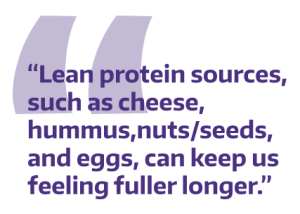
Lean protein sources, such as cheese, hummus, nuts/seeds, and eggs, can add more “bite,” keeping us feeling fuller a bit longer.
To find out how your snack rates, you can use the Smart snack product calculator, approved by the USDA.
On the other hand, not everyone will need snacks. For some, eating 3 regularly spaced, balanced meals can be sufficient to keep up energy levels throughout the day and meet nutrient needs.
Those needing snacks might include growing children, athletes, folks healing from wounds or infections, and folks with reduced appetite or intake due to underlying health conditions.
A snack is also a great idea if we have an extended period of time (>5 hrs) between our meals. Snacks help keep up our energy levels, keep our blood sugar levels in control, and aid with appetite control at the next meal.
What food items are you serving at the hospital?
MN: We have not changed our menus and are serving the same menu items as before the pandemic.
Does nutrition change once a person tests positive for the virus?
MN: There is currently no evidence that recommends a special diet for COVID-19. We have noticed that hospitalized patients that are able to take food by mouth generally are not feeling well enough to take adequate nutrition by mouth. These patients meet with a Registered Dietitian regularly to find foods and drinks that will meet their needs.
Are there any food items that are in short supply?
MN: We have noticed shortages of items here and there, but no clear pattern has emerged. We expect this will continue to evolve over the coming weeks.
3 Thoughts on “How to safely shop for food during COVID-19”
On April 28, 2020 at 9:25 AM, George Thomas, Jr. said:
Great tips, thanks! Been wondering about this.
On April 29, 2020 at 11:09 AM, Perry Acworth said:
These are great tips! The UW Farm will insert this info in our newsletter going out next week and today on FB!
On May 1, 2020 at 12:20 PM, Kathleen Mahan, RDN said:
Great article Megan and Iwona! Good sound practical information for these unusual times.
Comments are closed.